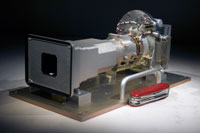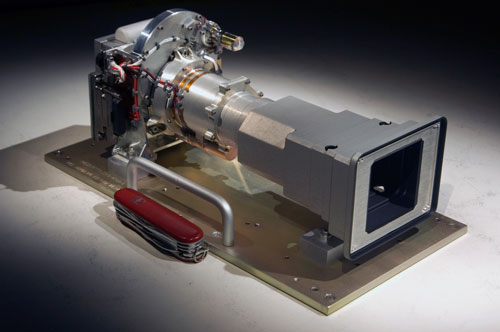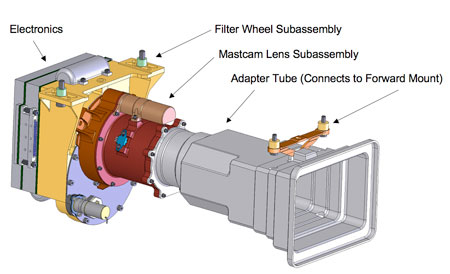Here are two cameras that Mars rover Curiosity will use to photograph the Red Planet
posted Monday, August 6, 2012 at 1:47 PM EDT
 This morning we shared with you a low resolution black-and-white photo that Curiosity, the truck-sized Mars rover, captured after successfully touching down on the Red Planet.
This morning we shared with you a low resolution black-and-white photo that Curiosity, the truck-sized Mars rover, captured after successfully touching down on the Red Planet.
In a few days, Curiosity will deploy its mast along with two additional, more sophisticated cameras to record higher resolution, color footage of Mars.
Here are pictures of those two cameras. Above right is the Mastcam 100mm fixed focal length camera head. Below is the Mastcam 34mm fixed focal length camera head.

The cameras are part of the Mars Science Laboratory (MSL) component of Curiosity. They are designed to capture color images, multispectral color images, stereo sound, and high definition video of the Martian terrain explored by Curiosity and the MSL.
Two "Mastcams" with zoom lenses were also developed by NASA but the agency halted work on them in 2011 because they did not believe they would be ready in time for the launch of Curiosity.
An intrepid Reddit photography user discovered more detail about the two Mastcams at this site. See the highlights below. (Also, check out the technical drawing of one of the cameras below.)
• One Mastcam camera head has a 100 mm focal length, f/10 lens. This provides the capability to obtain images with a scale of 7.4 centimeters per pixel at 1 km distance, and about 150 microns per pixel at 2 meters distance. The camera’s square field of view covers 5.1° over 1200 by 1200 pixels on the instrument’s 1600 by 1200 CCD.
• The other Mastcam camera head has a 34 mm focal length, f/8 lens. The camera’s 15° square field of view covers 1200 by 1200 pixels on a 1600 by 1200 CCD detector. The camera can obtain 450 microns per pixel images at 2 meters distance and 22 centimeters per pixel at 1 kilometer distance.• Each Mastcam uses a Bayer Pattern Filter CCD to obtain natural color pictures of a quality just like that of consumer digital cameras. [...]
• Each Mastcam camera head also has a filter wheel, so that images taken by looking through filters covering different, narrow visible and near-infrared wavelengths can be obtained. Filters for the 34 mm Mastcam are (in nanometers): 440, 525, 550, 675, 750, 865, 1034, and 440(neutral density). Filters for the 100 mm Mastcam are (in nanometers): 440, 525, 550, 800, 905, 935, 1035, and 880(neutral density). The neutral density filters are for viewing the Sun. Each filter wheel also includes a visually clear (actually infrared rejection coated) filter for nominal RGB (red, green, blue) imaging using the Bayer Pattern CCD.
The pre-launch images page says a test video was "40 MBytes, which is about a days worth of downlink from MSL."
(Via Reddit)
